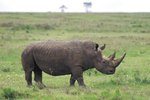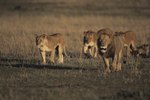Giraffes, lions and elephants are majestic animals that inhabit the wild lands of Africa and Asia (giraffes only live in Africa). The geographical diversity of these regions is just as fascinating as the animals themselves. Giraffes, lions and elephants have adapted to survive life in such habitats, which are often harsh and cruel. All three animals require different things in their surroundings to thrive, even though they may occupy the same territory.
Habitat Requirements
For animals to survive in the wild, they need a few basic things in their habitat. They require a food and water source, shelter and enough space to move. Giraffes and elephants need cover for protection from weather and predators, whereas lions only use shelter to escape the elements (with the exception of hiding vulnerable lion cubs). The terrain that giraffes, lions and elephants call home in Africa and Asia typically has plenty of plants and vegetation, different animal species (for lions) and watering holes. However, there are dry periods, causing these animals to travel the reaches of their habitats in search of sustenance.
Giraffes

Giraffes live in the dry savanna and dry open woodland areas of sub-Saharan Africa. Their habitat needs to have a good supply of trees -- they flock towards acacia trees in particular. Giraffes use their extremely long legs, necks and tongues to browse on the leaves and buds. They have a difficult time gathering food from the ground, so they aren’t usually found in treeless areas. Giraffes like to eat constantly and will eat hundreds of pounds of vegetation in a week. During rainy periods, they are found in deciduous woodlands, but congregate at watering holes or rivers when the weather is dry.
Lions

Lions occur in open grasslands, dense bush and scrubs areas and woodlands. African lions also roam the savannas of sub-Saharan Africa (semitropical or open tropical grasslands where long dry periods alternate with heavy raining). There is only a very small population of about 200 to 260 Asian lions left on the planet in the protected Gir Forest of India. Both the African and Asian lion’s habitats are similar in that they are grasslands that are scattered with trees. Their territory includes about 100 square miles that is guarded by male lions. In their habitat, lions not only have shade and cover but they also have a variety of prey species, such as antelopes, wildebeests and other large animals for the females to hunt.
Elephants

African savanna elephants also inhabit sub-Saharan Africa, but African forest elephants live in the dense rain forests of west and central Africa. Asian elephants are found in China, India, Sri Lanka and a large part of southeast Asia. Many of the Asian elephants live in tropical regions. The Indian elephant, a subspecies of the Asian elephant, uses subtropical forests and broad leaf tropical forests as its habitat. Some Asian elephants live in drier scrub lands. Elephants are often seen around watering holes, where they can drink and use the water to cool off during warm, dry spells. They eat 300 to 400 pounds of the leaves, bark, bamboo, grasses and roots found in their environment in a day.
References
Photo Credits
-
Jupiterimages/Photos.com/Getty Images




